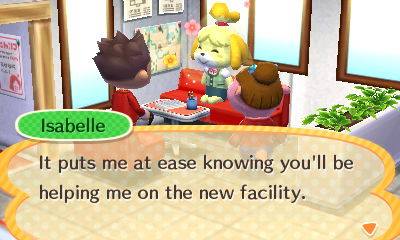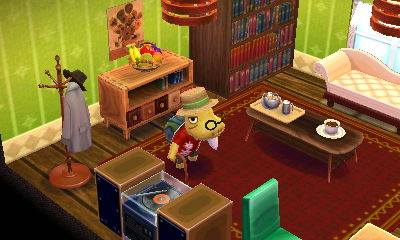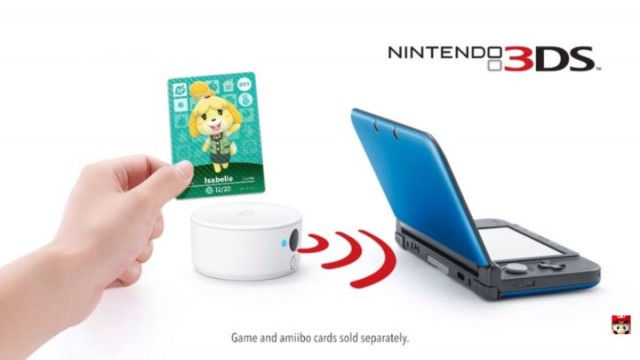Wonderful reworking of the classic Animal Crossing formula; Relaxing, addictive gameplay; Animal residents are adorable and funny; Designing and exploring the shops around town; Sharing designs with other players; Amiibo Card integration
Lack of challenge and proper rating system might frustrate some players; No home for players to design for themselves
Animal Crossing: New Leaf was a huge step forward for the series, and one of my favorite games that I’ve ever played. The appeal of Animal Crossing is in its nearly endless replay value, which is accomplished through new interactions and items to discover every single day, all delivered in real-time. From the original Animal Crossing on GameCube all the way through to New Leaf on 3DS, I’ve come to adore and build virtual relationships with countless animal neighbors, customized scores of pieces of furniture and rooms, and spent hundreds of hours enjoying the tranquility of my digital home away from home. With Animal Crossing: Happy Home Designer, however, Nintendo has attempted to take key elements of the franchise and rework them into a new experience that’s simultaneously familiar and different. Chalk it up as another success on 3DS, as Happy Home Designer is a real joy to play.
The basics of Animal Crossing are at the core of Happy Home Designer: forming bonds with animal residents, customizing homes, and building up a small town. Differentiating itself from past Animal Crossing games, though, Happy Home Designer has jettisoned a number of elements of the series in order to streamline and do something unique with the gameplay. The 24-hour clock is gone, the town is much smaller, and the animals are customers first, friends later. As the newest employee of Nook’s Homes (that racoon sure does get around), the player is tasked with taking on the townsfolk as clients and helping them design and build the homes of their dreams. The animals’ specifications are rarely any more complex than to craft an interior to fit a single color or theme, but the number of items available to get the job done is what makes the process so fun. The catalog of assets to pull from is enormous, easily one of the biggest in the series, and the variety is greater than ever. Players are limited to a single task per day, and must write a “report” (save the game) at the end of their shift, at which point they can either keep playing or quit for the time being.

This objective-based gameplay is entirely foreign to Animal Crossing titles, but surprisingly it works very well within the series’ framework. It’s largely successful because it doesn’t weigh the player down with too many demands. I loved that the animals would give me very basic instructions, leaving me with a lot of freedom to satisfy their wants. While it’s clear that a big chunk of the material in Happy Home Designer was lifted directly from New Leaf, tweaks have been made to the game engine that have finally addressed a number of desires I’ve long had for the series. Lighting, fans, and more can be placed on the ceiling. The underlying grid that every Animal Crossing title has for placing furniture and items has been modified to accommodate more minute adjustments, including the ability to finally place smaller objects right on the center of larger ones! For longtime fans, being able to more realistically place furniture and decorate rooms will be immensely rewarding, but it’s only a small part of Happy Home Designer‘s wonderful, touch-focused interface.
I enjoyed using the stylus to select items from the catalog, drag them around the environment, and reorient them (which is saying something, because you all know I love me some buttons). Traditional manual pushing and spinning is available, too, but the touch controls provide for a much speedier way of interacting. Being able to quickly copy assets by holding L and tapping them was a brilliant consideration on the part of the design team, and just one of many elements that contribute to Happy Home Designer’s smooth and intuitive interface. Switching between menus in the catalog can be a touch slow, however, and stands in contrast to the otherwise quick pace that the game has. I also was slightly bummed that the player doesn’t have a home of their own to go to and decorate. I would’ve loved to utilize Happy Home Designer’s much-improved designing tools to give myself the ultimate pad, and it feels like a missed opportunity, for sure. Still, I have to acknowledge that though Happy Home Designer plays in the same sandbox, it is its own game, separate from the main series.

- I designed this space for Tortimer, myself!
Despite being an offshoot of the Animal Crossing games, there are so many elements introduced here that I hope carry over into the next installment of the mainline series. Being able to design and completely customize a variety of establishments like schools and offices was another Animal Crossing itch that I’ve had, and assigning residents to different duties was similarly fun. I also appreciated that the way in which new jobs are meted out was varied and organic feeling. From going out to canvas on foot, to contacting animals via Amiibo Cards (more on those in a second), the game doesn’t simply plop customers down in front of the player, instead allowing them to have a hand in picking what job they want to take on next. The downtown that Nook’s Homes finds itself located in is the only environment that players can explore, but given that this isn’t intended to be a proper Animal Crossing title, I wasn’t bothered by the more limited game world. It’s just big enough to house a pleasing variety of shops to look through and customize.
I did find it disappointing that Happy Home Designer makes it a little too easy to resolve each animal’s request for its home. There’s no apparent benefit to meticulously design and decorate a living space versus haphazardly throwing things together, as the game doesn’t rate the quality of the player’s work. With no notable incentive to do good work beyond the satisfaction of a job well done, some players might feel miffed about the relative lack of difficulty that Happy Home Designer has to offer. That said, I think that being unhappy with the title’s easier challenge is missing the point a bit, frankly. Animal Crossing games aren’t about “winning” in a traditional sense. Happy Home Designer does mix things up by throwing in objectives, but they feel more like a guide than anything else. This is about having fun, being creative, and cutting loose as a designer in ways that previous Animal Crossings haven’t allowed. With the ability to share creations over the Nintendo Network, it further reinforces the notion that Happy Home Designer wants people to spend more time enjoying themselves than fretting about being evaluated by the computer over where they decided to place a fruit basket.

Whether using Happy Home Designer’s NFC Reader accessory on older 3DS models, or simply tapping them to the touch screen of a New 3DS, Amiibo Cards are a unique and entertaining part of Happy Home Designer. Each card represents an animal resident and can be used to pull them into the game. Whether to call them as a client with a job to complete, or to pull them into another animal’s home for photo-taking shenanigans, the Amiibo Cards provide a different way of experiencing Happy Home Designer. They’re not essential to the game, as it’s completely possible to play without them, but I highly recommend snagging a pack or two and diversifying the experience even further. It’s an awesome addition to the Amiibo line, and they’ve made me anxious to see what else Nintendo can do with the concept in the future.
Happy Home Designer is a different kind of Animal Crossing. From its pacing to its objectives, the game will delight fans with its new take on the series’ longstanding gameplay. It’s not the life-sim of years past, but Happy Home Designer’s successful re-imagining of what makes Animal Crossing tick is a lovely departure that I sincerely hope Nintendo explores again in the future. Go and snag yourself a copy today!




 ShareThis
ShareThis






